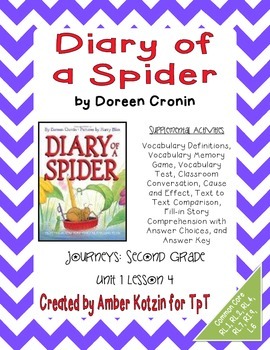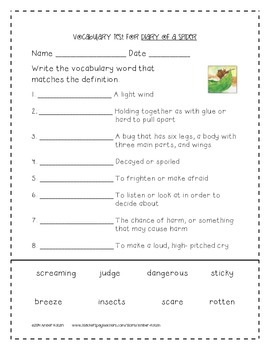Diary of a Spider Supplemental Activities 2nd Grade Journeys Unit 1, Lesson 4
Amber Kotzin
4.1k Followers
Grade Levels
2nd, Homeschool
Subjects
Resource Type
Standards
CCSSK.CC.A.1
CCSSK.CC.A.3
CCSSK.CC.B.4b
CCSSK.CC.B.5
CCSS2.MD.C.7
Formats Included
- PDF
Pages
11 pages
Amber Kotzin
4.1k Followers
What educators are saying
This made lesson planning so much easier and saved me a lot of time! The students really enjoyed completing this as well!
Description
This is an 8 page supplemental set with an answer key to accompany "Diary of a Spider" by Doreen Cronin. This is a story from the © 2014 2nd grade Journeys series by Houghton Mifflin Harcourt as Unit 1 Lesson 4.
This includes:
Vocabulary Definitions (1 page)
Vocabulary Memory Match (1 page)
Vocabulary Test (1 page)
Classroom Conversation (1 page)
Cause and Effect (1 page)
Text to Text Comparison (1 page)
Story Comprehension (1 page)
Story Comprehension Answer Choices (1 page)
Answer Key (1 page)
To see how I use these Journeys Supplements in my own classroom, download the Guide to Using Journeys Supplements for free.
Please check out the PREVIEW before purchasing!
Thanks for looking! Feel free to check out my blog!
This includes:
Vocabulary Definitions (1 page)
Vocabulary Memory Match (1 page)
Vocabulary Test (1 page)
Classroom Conversation (1 page)
Cause and Effect (1 page)
Text to Text Comparison (1 page)
Story Comprehension (1 page)
Story Comprehension Answer Choices (1 page)
Answer Key (1 page)
To see how I use these Journeys Supplements in my own classroom, download the Guide to Using Journeys Supplements for free.
Please check out the PREVIEW before purchasing!
Thanks for looking! Feel free to check out my blog!
Total Pages
11 pages
Answer Key
N/A
Teaching Duration
1 Week
Last updated Jul 7th, 2014
Report this resource to TPT
Reported resources will be reviewed by our team. Report this resource to let us know if this resource violates TPT’s content guidelines.
Standards
to see state-specific standards (only available in the US).
CCSSK.CC.A.1
Count to 100 by ones and by tens.
CCSSK.CC.A.3
Write numbers from 0 to 20. Represent a number of objects with a written numeral 0-20 (with 0 representing a count of no objects).
CCSSK.CC.B.4b
Understand that the last number name said tells the number of objects counted. The number of objects is the same regardless of their arrangement or the order in which they were counted.
CCSSK.CC.B.5
Count to answer “how many?” questions about as many as 20 things arranged in a line, a rectangular array, or a circle, or as many as 10 things in a scattered configuration; given a number from 1-20, count out that many objects.
CCSS2.MD.C.7
Tell and write time from analog and digital clocks to the nearest five minutes, using a.m. and p.m.





